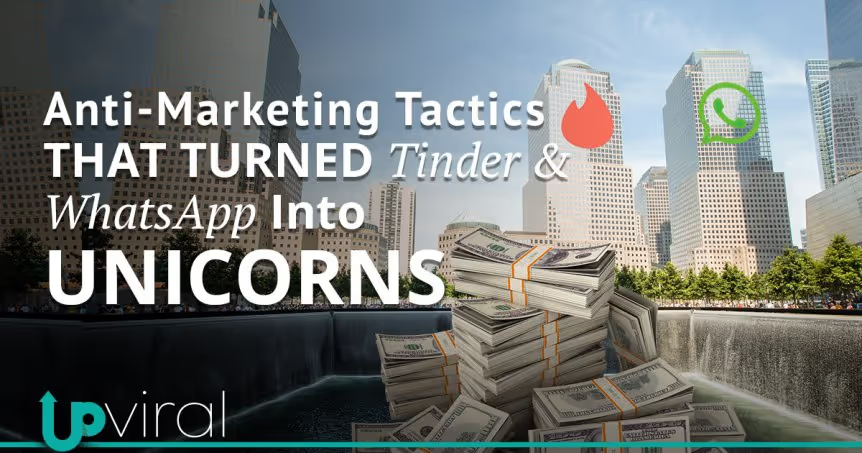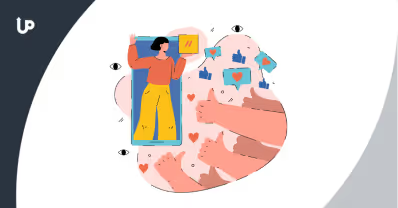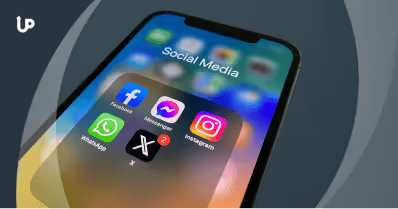We live in a constantly changing landscape, and nothing has advanced as fast as technology. These advancements that let people have mini computers in their pockets at all times have caused a monumental shift in the way people are sold things. The old days of ad revenue coming from commercials and billboards are over.
Companies have been forced to adapt by producing ads that not only get someone's attention on one platform but ensure the message and experience are consistent across numerous devices. This is something that wasn’t even heard of just 5 years ago, and this shift from single media to multi-platform has also seen the rise of anti-marketing.
What is anti-marketing?
Anti-marketing, as the name suggests, is a way to market a product that weakens the existing brand, and makes it look worse. This, in turn, can actually end up having a positive effect overall, though traditional marketing wisdom would say otherwise.
As an example, if you were trying to market your Halloween store, traditional marketing might showcase the large selection or lowest prices. This ad from Brandable Clothing does away with all of that and gets straight to the point:

Some other cornerstones of anti-marketing include:
- Less noise, more surprise
- Attraction rather than promotion
- Simplicity and exclusivity
- Reverse psychology
Traditional marketing is only used to reinforce a brand identity and ideals, but anti-marketing flips this on its head. In this post, we’re going to examine the 8 tactics that WhatsApp and Tinder used to see explosive growth.
1 - No In App Ads
The goal of nearly any app is to turn a profit, and with customers being weary of a 99¢ price tag many developers have opted to make the app free and serve in app ads. If enough people download your app and click on the ads, it could be a big payday. The problem is, to see the big pay day you’re hoping for, you’ll need to have hundreds of thousands of active users to even see a small profit.
In app ads can clutter an app and take away from the overall user experience. Early on the founders of WhatsApp decided on a no-nonsense attitude to keep things as simple as possible. In fact, Koum (WhatsApp co-founder) has a note taped to his desk from Acton that reads “No Ads! No Games! No Gimmicks!”

Not running ads can be risky, and requires a long term approach to see any profits, but WhatsApp has made it work for them.
Quick anti marketing takeaway:
- Do not run in app ads
- Keep the user experience as simple as possible
- Make your app free, if possible.
2 - Word Of Mouth
Any marketer knows word of mouth is the best kind of advertising, but it is extremely hard to obtain. Once it starts, though, it can really take off, as evidenced by WhatsApp’s current and future growth. In fact, it is the only way WhatsApp is continuing to grow, with no money spent on advertising, and only relatively few articles ever written about them.
So how did they achieve this massive word-of-mouth growth?
Well, when something works, people like to tell their friends about it. When the thing you’re telling your friends about is also a messaging app which can connect you and save money, you’ve got a perfect storm. This formula sums up what they had going for them in the early days, and still do today.
Bringing people together + cheaper than the alternative + private and easy to use = viral success.
Within each of these ingredients are anti-marketing tactics that contributed to their massive success. Quick anti marketing takeaway:
- Give people something to talk about
- Make it easy to share
- Focus on a seamless user experience
3 - Backwards Compatible
Conventional wisdom and advertising say go for the best and the newest. Let your app or game run best on the newest devices, and pull support for older versions. WhatsApp did just the opposite: they focused on making it work (really well) on older “dumb” phones.
This opened up their potential market reach, as not everyone can afford to buy the latest and slightly faster and thinner greatest phone every few months - especially in the developing world, where a large portion of their users are based.
Another defining aspect of WhatsApp that brought people together was its cross-platform functionality. If two people have iPhones, they can send a text message on the data network as an iMessage rather than an SMS. The same is true of Androids and Blackberries with BBM. That’s all well and good if all of your friends have the same phone, but, in reality, most friend groups don’t, and this was a huge opportunity for WhatsApp.
This focus on breaking the restrictions in place and crossing borders helped bring users together all over the world and certainly got people talking. They didn’t limit themselves to a local market, but were focused on the global aspect from the start.
Quick anti marketing takeaway:
- Ensure your app is optimized for older versions
- Enable seamless cross platform communication
- “Dumb” phones are still out there and needs apps too
4 - Cheaper than the alternative
These days a lot of younger people don’t even remember the time when text messages were only sent as SMS or MMS. Before the advent of solid data networks, phone companies were making a killing on text messages - some charged per message, some implemented surge pricing at busy times, and some limited texts altogether.
When it first came out, it was completely free without any ads. Then for a while, they would shift from charging 99 cents at some points, to help cover the high costs of SMS confirmations necessary to continue running, to being free other times. When you contrast 99 cents for unlimited text messages worldwide against the plans that were in place, it’s crystal clear why people quickly made the switch.
Rather than making money on the back end, they chose to only charge a dollar in exchange to know as little about you as possible. If that’s not anti-marketing, I don’t know what is, and this brings us to the next major factor in its success.
Quick anti marketing takeaway:
- Make it free if possible
- Assess the competition and under cut their costs
- Make money in the long run, not short term
5 - Private and easy to use
The founders took privacy seriously from the get-go. Not only do they tout their network and connections as completely private, but possibly the more important factor is that they don’t collect or require any information when signing up other than your phone number.
No name, email, username or password.
From a conventional marketing standpoint, this is crazy. We’re in the digital age, and each person can have hundreds of data points about them. These points can then be used to sell targeted ads to countless agencies for lots of money. To flat out turn down that opportunity seems counter-intuitive. And that’s part of their anti-marketing success.
Quick anti marketing takeaway:
- Collect as little user info as possible
- Make signing 3 steps or less
- Value users privacy
6 - Supply and demand
With any business, you need to have an equilibrium between supply and demand to have a successful marketplace. Tinder understood that in order to succeed it would need to stack the market with supply, or in it’s case women using the app. The marketing team reasoned that if more women were on it, it would attract male users to see who was available for a date. Rather than just launching the app and hoping for the best, Tinder stacked the deck in its favor.
They initially launched the app only to sororities first. This not only seeded the marketplace with women but benefited from the social aspect of sororities, and word of mouth began to spread about the app. This tactic isn’t new and is the same reasoning for ladies night, used by almost all clubs. As an added benefit, women in sororities were typically millennials who are tech savvy, focus on mobile use, and love to share new things with friends.
After only one trip across the country, pitching to sororities, they went from less than 5,000 users to around 15,000 - nearly 200% growth! The anti-marketing hack here is keeping it exclusive. Rather than opening it up to as many people as possible, they focused only on a small group of people in their target audience to ensure success.
Quick anti marketing takeaway:
- Don’t have a big flashy launch
- Stack supply in your favor before launch
- Keep it exclusive
7 - Gamification
Whereas traditional dating apps like Match.com, Plenty Of Fish, and OkCupid valued their users creating a carefully put together persona (about paragraph, likes, dislikes, activities, etc.), Tinder did away with all that, and exploited psychological fundamentals of reward.
Their fast and easy-to-use user interface made it possible to flip through a ‘deck’ of potential people quickly and easily. This contrasts with the traditional approach of sending a personal message to someone on the other sites.
This simple UI also made use of pictures integral, giving people only a split second to make a decision about the person.
Not only did this take advantage of people’s psychology by focusing only on physical attraction and ‘love at first sight’, but it also exploited gambling psychology, which casinos have been using forever, and made the app fun and addictive.
Quick anti marketing takeaway:
- Just because the competition is boring doesn’t mean you need to be
- Make your app quick and satisfying to use
- Exploit gambling psychology
8 - Double Opt-in
If you’ve ever used an online dating app, and you are a woman, you almost certainly know about the influx of unsolicited messages you can get. Not only is this annoying, but it is a huge waste of your time. There’s no way someone would spend all their time double checking these unsolicited messages to make sure that “the love of their life” didn’t send a message.
The anti marketing tactics that Tinder used to overcome this hurdle was by implementing a double opt-in. Both parties swiped right and therefore consented to like each other (or at least the picture). This reduces the fear of rejection and increases the benefit and good feeling of making a match
Isie Lapowski of Wired summarizes this really well:
“Sites like OKCupid and Match.com have never been able to hack the rejection problem. They haven’t simplified the process much, either, still prompting users to fill out those long and antiquated dating surveys. The process is a drag. Rejection is disappointing. And the fact that you’re doing it anyway only plays into the lonely stereotype that the online dating industry has had such a tough time shrugging off.”
Quick anti marketing takeaway:
- Make both parties consent to meeting
- Don’t annoy users with unwanted notifications
- Eliminate outright rejection
Conclusion
WhatsApp and Tinder are quite different apps serving different purposes, both shared their amazing success by using anti-marketing techniques. So the next time you’re working on marketing a product, think about what the opposite would be, and the potential benefits it could have from going against the norm.
Viral marketing isn’t easy to do, and it usually takes a team of experts to really see results. If you’re interested in explosive viral growth you should reach out to the team here at Upviral. They have lots of experience creating successful viral marketing campaigns, contests and referral systems that actually work to generate hundreds of thousands of quality leads. Even if you just have a question, they would be happy to point you in the right direction and are a blast to work with.





.png)